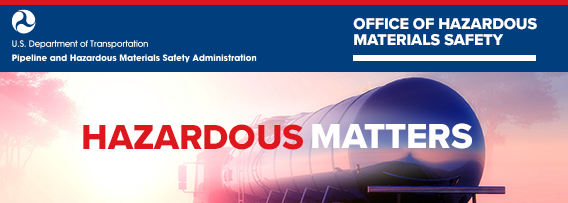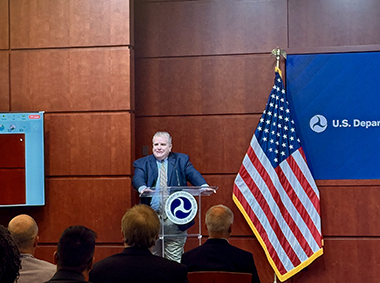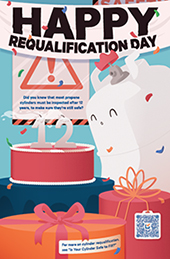Hazardous Matters July - September 2025

"Hazardous Matters" is the quarterly newsletter for PHMSA's Office of Hazardous Materials Safety (OHMS). As always, it is packed with the latest news, expert tips, and essential insights for the safe handling and shipment of hazardous materials. Stay informed, stay safe!
July - September 2025
A Message from PHMSA's Acting Associate Administrator for Office of Hazardous Materials Safety
 Having recently been selected to serve as the Acting Associate Administrator for Hazardous Materials Safety, I would like to share my appreciation to the PHMSA leadership team, as well as Secretary Duffy for their commitments to improving safety across the country.
Having recently been selected to serve as the Acting Associate Administrator for Hazardous Materials Safety, I would like to share my appreciation to the PHMSA leadership team, as well as Secretary Duffy for their commitments to improving safety across the country.
My vision for the Office of Hazardous Materials Safety begins with a foundation of partnership and technology. These two pillars are not only essential to how we operate, but how we lead nationally in advancing hazardous materials safety.
Through strong partnerships—with industry, first responders, federal and state agencies, researchers, and the public—we will foster a shared commitment to safety and a collaborative approach to problem-solving. These relationships will enable us to better anticipate risks, close gaps, and align our efforts toward a common goal: preventing hazardous materials incidents before they occur.
At the same time, we will embrace technology to modernize how we collect data, monitor shipments, and respond to incidents. We will invest in tools and systems that improve visibility, increase efficiency, and provide real-time information to decision-makers in the field and here in Washington, D.C. Innovation will be central to how we keep pace with emerging threats and the evolving nature of hazardous materials transport.
With these foundations in place, I envision our office making significant and impactful progress as we set the standard for improving the safe transport of hazardous materials. This cannot be accomplished without enhancing the effectiveness of our preparedness and emergency response capabilities. Our impact will be seen in fewer incidents, stronger community protections, and a safety culture that leads by example.
This is a vision rooted in purpose, driven by data, and powered by collaboration—and together, I believe we will achieve it.
William Quade
Acting Associate Administrator, PHMSA

Lithium Battery Air Safety Advisory Committee Concludes
The Lithium Battery Air Safety Advisory Committee (Committee) was disbanded on May 9, 2025, as required by statute. The Committee met biannually for five years and facilitated communication between the Department and representatives from a diverse group of lithium battery stakeholders, including battery and product manufacturers, air carriers, pilots, and shippers.
The Committee provided a forum for discussing new technologies and transportation safety practices, receiving feedback for discussions at international forums, and offered mechanisms to increase awareness of relevant transport requirements and incidents involving lithium batteries in air transport.
PHMSA extends its appreciation to the members of the Committee whose expert insights, collaborative spirit, and commitment to safety provided outputs that have informed policy and helped advance practical solutions to complex safety challenges.
Please see the Committee homepage for more information on members, meeting minutes, and the Committee's Report to Congress.
Opportunity for Collaboration – Hazardous Materials: Mandatory Regulatory Reviews to Unleash American Energy and Improve Government Efficiency
On June 4, 2025, the Federal Register published PHMSA's Advance Notice of Proposed Rulemaking (ANPRM) titled "Hazardous Materials: Mandatory Regulatory Reviews to Unleash American Energy and Improve Government Efficiency," also known as HM-265B.
PHMSA is seeking feedback on whether to repeal or amend any requirements in the Hazardous Materials Rulemaking Procedures and Program Procedures, or the Hazardous Materials Regulations to eliminate undue regulatory burdens on the identification, development, and use of domestic energy resources and to improve government efficiency. The ANPRM comment period ends August 4, 2025. PHMSA will consider late-filed comments to the extent practicable.
- The PDF version of the ANPRM can be viewed online at GovInfo.gov.
- The long form HTML version of the ANPRM can be viewed online at FederalRegister.gov.
Hazardous Materials: Liquified Natural Gas by Rail (HM-264)
On June 23, 2025, the Office of the Federal Register published PHMSA's Notification of conforming amendments titled "Hazardous Materials: Liquified Natural Gas by Rail." PHMSA published this Notification to amend the Hazardous Materials Regulations (HMR) in response to the recent decision of the United States Court of Appeals for the District of Columbia Circuit in Sierra Club, et al. v. DOT, et al., No. 20-1317 (Jan. 17, 2025). These conforming amendments restore the text of the HMR to the version that existed prior to the August 24, 2020, effective date of the LNG by Rail Rule. No other regulatory changes were adopted.
Hazardous Materials Deregulatory NPRMs
On July 1, 2025, PHMSA published 17 new Notice of Proposed Rulemaking (NPRM) documents in the Federal Register. These NPRMs are part of a DOT-led effort to eliminate outdated, unnecessary, and overly burdensome regulatory requirements within the Hazardous Materials Regulations (HMR). The comment period for these NPRMs closes on September 2, 2025. This list of NPRMs includes:
- HM-268A: Reducing Burdens on Domestic Aerosol Shippers Proposes to revise the aerosol definition in § 171.8 to remove the requirement that it contain a liquid, powder, or paste. This would let small quantities of gas be shipped in aerosol containers instead of more costly cylinders or needing a special permit, aligning with international standards—helping U.S. companies compete globally.
- HM-268B: Reducing Costs to Domestic Shippers and Carriers of Limited Quantities Proposes allowing a smaller limited quantity marking in § 172.315(a)(2), reducing packaging and labeling costs and helping carriers move more packages per trip.
- HM-268C: Reducing Burdens on Domestic Companies Using Battery-Powered Equipment in Trades Proposes updating § 173.6 to increase the amount of lithium batteries allowed under the Materials of Trade (MOTs) exception. This would help companies using battery-powered equipment, like landscapers, to transport needed tools.
- HM-268D: Hazardous Materials: Reducing Burdens to Domestic Carriers Proposes allowing emergency response information to be displayed electronically, removing the current requirement for printed copies and easing compliance for shippers.
- HM-268E: Remove Redundant List of U.S. EPA CERCLA Hazardous Substances Proposes referencing the40 CFR § 302.4 hazardous substance list instead of duplicating it, eliminating 27 pages of duplicative regulatory text in the 49 CFR.
- HM-268F: Reducing Burdens by Allowing Continued Use of DOT Special Permit Packaging Proposes allowing the continued use of DOT special permit packaging for its full lifespan, even if the permit is not renewed or the original holder no longer exists.
- HM-268G: Improving Efficiencies for Special Permits and Approvals RenewalsProposes removing the rule requiring special permit renewal applications sixty days before expiration. This would reduce paperwork and allow permit use provided the renewal is filed before expiration.
- HM-268H: Modernizing Payments to and From America's Bank Account Proposes requiring electronic payment for registration fees, eliminating outdated provisions allowing certified checks to improve payment efficiency.
- HM-268I: Removing Paperwork Burdens on Domestic Motor Carriers Proposes removing the requirement in § 107.620 for motor and vessel carriers to carry paper copies of their registration. Digital verification would be allowed as an additional option, reducing unnecessary paperwork.
- HM-268J: Reduce Training Burdens for American Farmers Proposes raising the income threshold for farmers exempt from security training from $500,000 to $825,000 to reflect inflation and ease burdens on small and mid-size farms.
- HM-268K: Removing Burdensome Rail Reporting Requirements Proposes removing outdated rail regulations and reporting requirements, such as references to steam-era materials and unnecessary reporting to non-federal groups like the Bureau of Explosives.
- HM-268L: Adopt DOT Special Permits 12412 and 11646 into the HMR Proposes adopting special permits allowing DOT-specification intermediate bulk containers (IBC) and drums to be unloaded while still on transport vehicles when specific safety control measures are followed, easing burdens for various small businesses.
- HM-268M: Adopt DOT-SP 21287 into the HMR Proposes adopting a special permit allowing small refrigerating machines with low-risk flammable gases (A2L) to be transported like non-flammable refrigerant gasses, easing compliance burdens.
- HM-268N: Adopt DOT-SP 21379 into the HMR Proposes adopting a special permit allowing large refrigerating systems with A2L gases to be transported under the same rules as systems using non-flammable refrigerant gases, reducing compliance burdens.
- HM-268O: Adopt DOT-SP 14175 into the HMRProposes extending the requalification interval for certain gas cylinders from 5 to 10 years, reducing testing costs for companies using these cylinders.
- HM-268P: Adopt DOT-SP 21478 into the HMR Proposes allowing empty IBCs with only residue to be transported like non-bulk packages, reducing costs for the IBC reconditioning industry.
- HM-268Q: Allow Fireworks Certification Agencies (FCAs) to Approve Professional Fireworks Proposes allowing FCAs to approve both consumer and professional fireworks, speeding up approvals and easing the workload on federal staff.

Opportunity for Collaboration: Requests for Information (RFI) on Fiber Reinforced Plastic (FRP) Portable Tanks
The Office of Hazardous Materials Safety Research Development and Technology (RD&T) program is pleased to announce the release of two RFIs, titled "FRP Portable Tank Material Articles" and "Laboratory Capabilities to Test Fiber Reinforced Plastic Materials (FRP) and Portable Tanks made with FRP Materials." These two RFIs aim to evaluate material fatigue, pool fire test suitability, impact testing for packaging qualifications, and optimal non-destructive test methodologies for FRP Portable Tanks.
The information gathered will provide critical insights that could pave the way for PHMSA to successfully adopt FRP Portable Tanks into the Hazardous Materials Regulations to enhance safety and efficiency in hazardous materials transport.
PHMSA invites professionals and experts in the field of FRP Portable Tanks to contribute their insights by responding to the RFIs. Your input is invaluable in advancing safety and innovation in this important area. The RFIs can be found in the Federal Register Notice at the link below. We look forward to your responses and collaboration!
- FRP Portable Tank Material Articles
- Laboratory Capabilities to Test Fiber Reinforced Plastic Materials (FRP) and Portable Tanks made with FRP Materials
Innovative Method to Safely Deactivate Batteries
We're excited to announce the publication of PHMSA-funded work conducted by the Naval Research Laboratory (NRL). This groundbreaking paper details a new method for safely removing residual energy from used batteries— a major step toward safer handling and transport of end-of-life lithium-ion cells.
Residual energy in end-of-life batteries can pose serious risks, including the potential for fire and the release of toxic gases during storage and shipping. While current deactivation options exist, many are either slow, difficult to apply in the field, or carry safety risks of their own. The NRL team's new approach addresses these limitations with a simple, effective method that neutralizes multiple battery types efficiently.
In testing, this technique significantly reduced the hazards associated with residual energy—eliminating thermal runaway events and drastically decreasing the release of flammable and toxic gases. The solution could reshape how the industry handles battery deactivation and disposal, making the process safer, faster, and more scalable.
Read the full paper and explore the future of battery safety: HERE

Celebrate Safely this Summer Season
The only thing that beats backyard barbecues and watching fireworks on the 4th of July is being able to do so safely! Check out the following publications to learn how you can help that happen.
 As 4th of July celebrations wind down, retailers or retailer employees may be wondering what to do with any unsold fireworks.
As 4th of July celebrations wind down, retailers or retailer employees may be wondering what to do with any unsold fireworks.
The "Safe Returns: Understanding Hazmat Returns and the Reverse Logistics Exception" resource is meant to help those within the reverse logistics stream—including retailers and retail employees—understand how the Hazardous Materials Regulations (HMR) pertain to their industry.
The brochure explains the applicability of the HMR to hazardous materials return shipments, unpacks the HMR definition of "reverse logistics," and details the provisions authorized for reverse logistics transportation.
Have you Checked the Box for your next Outdoor Adventure?
 There is nothing like enjoying the warm summer air while doing your favorite outdoor activities, but did you know that some of the supplies you bring camping, hiking, or hunting are considered hazardous materials?
There is nothing like enjoying the warm summer air while doing your favorite outdoor activities, but did you know that some of the supplies you bring camping, hiking, or hunting are considered hazardous materials?
Help keep hazardous material incidents once in a blue moon by checking out the Check the Box Outdoors Brochure.
Something for the Kids
Are you and the family planning to road trip to your campsite? Get the kids off their phones and tablets early with PHMSA's free Hazardous Matt Activity Book. Keep the kids entertained while they learn about hazmat safety by helping Hazardous Matt and his friends solve puzzles and play games!
Are you the Grill Master ready to impress the neighborhood with your outdoor cooking skills? Not if your propane cylinder isn't.
 Check out PHMSA's new "Is your Cylinder Safe to Fill?" resource guide. The propane cylinder safety poster assists fillers with inspecting cylinders for serviceability before filling, based on Hazardous Materials Regulations cylinder requalification standards.
Check out PHMSA's new "Is your Cylinder Safe to Fill?" resource guide. The propane cylinder safety poster assists fillers with inspecting cylinders for serviceability before filling, based on Hazardous Materials Regulations cylinder requalification standards.
It reflects the October 30, 2020, final rule, which authorized 12-year initial and subsequent requalification periods for volumetric expansion testing and a 12-year initial requalification period for proof pressure testing.
PHMSA develops compliance assistance materials that make it easier to understand and comply with the HMR. Electronic versions of these resources are available at: https://www.phmsa.dot.gov/training/hazmat/publications
The Hazardous Materials Information Center (HMIC) has been an essential resource for PHMSA, staffed by highly trained specialists ready to assist with the wide range of regulatory questions received each day for more than 25 years.
Operating Monday through Friday, from 9:00 AM to 5:00 PM Eastern Time, HMIC staff are well-versed in the Hazardous Materials Regulations (49 CFR Parts 171-180), as well as related federal and state requirements.
In addition to their regulatory expertise, the HMIC specialists bring strong customer service skills and professionalism to every interaction. The HMIC continues to serve both the transportation industry and the American public, playing a vital role in promoting hazardous materials safety across the United States.
For additional information contact:
The Hazardous Materials Info Center
1.800.HMR.4922 or (1.800.467.4922)
E-mail: infocntr@dot.gov
Questions or suggestions for the next newsletter? Email Training@dot.gov, with the subject: "Newsletter."
To subscribe to Hazardous Matters, Click Here.
To access archival issues of this newsletter, Click Here.
